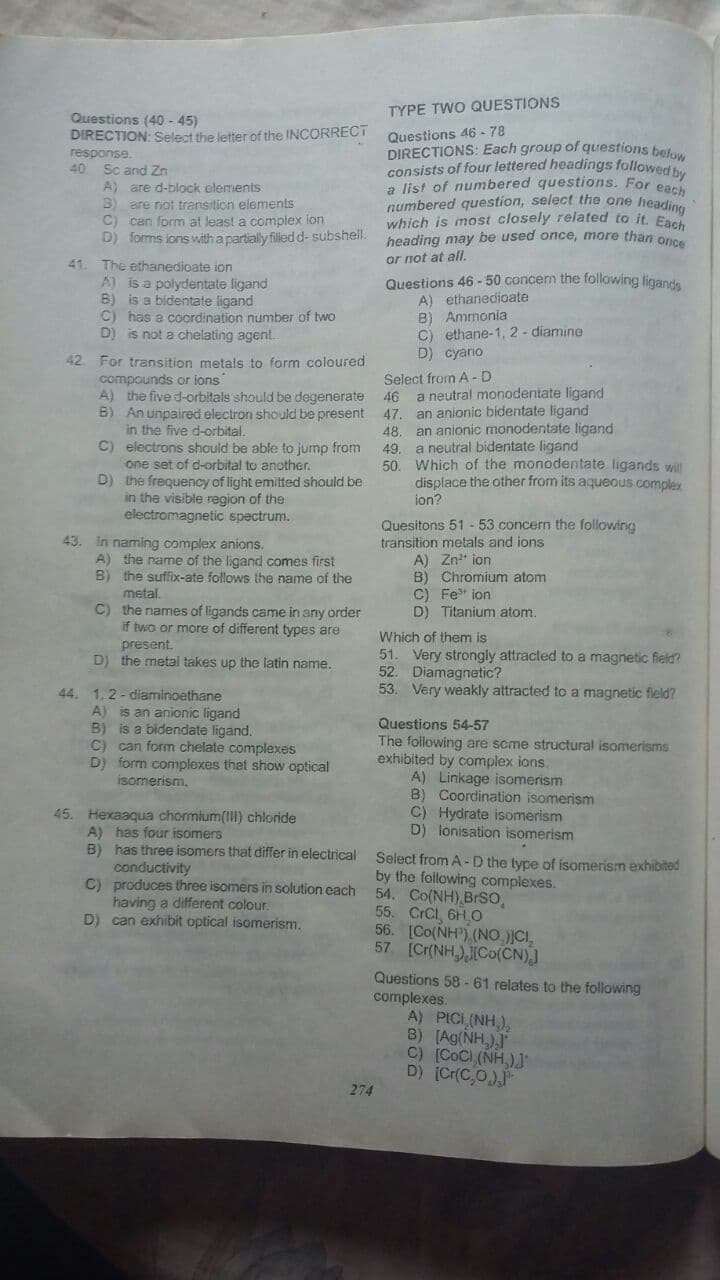Questions (40 - 45) DIRECTION: Select the letter of the INCORRECT response. 40. Sc and Zn A) are d-block clements B) are not transition elements C) can form at least a complex ion D) forms lons with a partially filled d- subshell.
Questions (40 - 45) DIRECTION: Select the letter of the INCORRECT response. 40. Sc and Zn A) are d-block clements B) are not transition elements C) can form at least a complex ion D) forms lons with a partially filled d- subshell.
Chemistry
10th Edition
ISBN:9781305957404
Author:Steven S. Zumdahl, Susan A. Zumdahl, Donald J. DeCoste
Publisher:Steven S. Zumdahl, Susan A. Zumdahl, Donald J. DeCoste
Chapter1: Chemical Foundations
Section: Chapter Questions
Problem 1RQ: Define and explain the differences between the following terms. a. law and theory b. theory and...
Related questions
Question
Answer Q40, 41, 42 showing detailly all explanations

Transcribed Image Text:TYPE TWO QUESTIONS
Questions (40 - 45)
DIRECTION: Select the letter of the INCORRECT
response.
40 Sc and Zn
A) are d-block clements
B) are not transition elements
C) can form at least a complex ion
D) formis ions with a partially filledd- subshell.
Questions 46 - 78
DIRECTIONS: Each group of questions bef
consists of four lettered headings fallowed by
a list of numbered questions. For ea
numbered question, select the one heading
which is most closely related to it. En
heading may be used once, more than once
or not at all.
41. The ethanedioate ion
A) is a polydentate ligand
B) is a bidentate ligand
C) has a coordination number of two
D) is not a chelating agent.
Questions 46 - 50 concem the following figande
A) ethanedioate
B) Ammonia
C) ethane-1, 2- diamine
D) cyario
42 For transition metals to form coloured
compounds or ions
A) the five d-orbitals should be degenerate 46 a neutral monodentate ligand
B) An unpaired electron should be present 47. an anionic bidentate ligand
in the five d-orbital.
C) electrons should be able to jump from
one set of d-orbital to another.
D) the frequency of light emitted should be
in the visible region of the
electromagnetic spectrum.
Select from A -D
48. an anionic monodentate ligand
49. a neutral bidentate ligand
50. Which of the monodentate ligands wll
displace the other from its aqueous complex
ion?
43. In naming complex anions.
A) the name of the ligand comes first
B) the suffix-ate follows the name of the
Quesitons 51 -53 concern the following
transition metals and ions
A) Zn* ion
B) Chromium atom
C) Fe" ion
D) Titanium atom.
metal.
C) the names of ligands came in any order
if two or more of different types are
Which of them is
51. Very strongly attracted to a magnetic field?
52. Diamagnetic?
53. Very weakly attracted to a magnetic fleld?
present.
DJ the metal takes up the latin name.
44. 1.2-diaminoethane
A) is an anionic ligand
B) is a bidendate ligand.
C) can form chelate complexes
D) form complexes thet show optical
Questions 54-57
The following are scme structural isomerisms
exhibited by complex ions.
A) Linkage isomerism
B) Coordination isomerism
C) Hydrate isomerism
D) lonisation isomerism
isomerism.
45. Hexaaqua chormium(II) chloride
A) has four isomers
B) has three isomers that differ in electrical
conductivity
C) produces three isomers in solution each
having a different colour.
D) can exhibit optical isomerism.
Select from A - D the type of isomerism exhibited
by the following complexes.
54. Co(NH) BrSo,
55. CrCi, 6H O
56. [Co(NH), (NO.)CI,
57 (Cr(NH),ICo(CN)
Questions 58 - 61 relates to the following
complexes.
A) PICL(NH,),
B) [Ag(NH,)
C) [CoCi (NH,)J
D) [Cr(C,O)
274
Expert Solution
This question has been solved!
Explore an expertly crafted, step-by-step solution for a thorough understanding of key concepts.
Step by step
Solved in 3 steps

Knowledge Booster
Learn more about
Need a deep-dive on the concept behind this application? Look no further. Learn more about this topic, chemistry and related others by exploring similar questions and additional content below.Recommended textbooks for you

Chemistry
Chemistry
ISBN:
9781305957404
Author:
Steven S. Zumdahl, Susan A. Zumdahl, Donald J. DeCoste
Publisher:
Cengage Learning

Chemistry
Chemistry
ISBN:
9781259911156
Author:
Raymond Chang Dr., Jason Overby Professor
Publisher:
McGraw-Hill Education

Principles of Instrumental Analysis
Chemistry
ISBN:
9781305577213
Author:
Douglas A. Skoog, F. James Holler, Stanley R. Crouch
Publisher:
Cengage Learning

Chemistry
Chemistry
ISBN:
9781305957404
Author:
Steven S. Zumdahl, Susan A. Zumdahl, Donald J. DeCoste
Publisher:
Cengage Learning

Chemistry
Chemistry
ISBN:
9781259911156
Author:
Raymond Chang Dr., Jason Overby Professor
Publisher:
McGraw-Hill Education

Principles of Instrumental Analysis
Chemistry
ISBN:
9781305577213
Author:
Douglas A. Skoog, F. James Holler, Stanley R. Crouch
Publisher:
Cengage Learning

Organic Chemistry
Chemistry
ISBN:
9780078021558
Author:
Janice Gorzynski Smith Dr.
Publisher:
McGraw-Hill Education

Chemistry: Principles and Reactions
Chemistry
ISBN:
9781305079373
Author:
William L. Masterton, Cecile N. Hurley
Publisher:
Cengage Learning

Elementary Principles of Chemical Processes, Bind…
Chemistry
ISBN:
9781118431221
Author:
Richard M. Felder, Ronald W. Rousseau, Lisa G. Bullard
Publisher:
WILEY